Intro | Events | Shows | AGM | Monthly Tips
Cutting Garden | Gardening Year | Archive
|
RHS's top 10 tips per month for the Garden |
H&DGC are members of the RHS - www.rhs.org.uk |
January | February | March | April | May | June | July
August | September | October | November | December |
(For monthly rainfall figures click here) |
| January |
- Recycle your Christmas tree by shredding it for mulch
- Ventilate the greenhouse on sunny days
- Dig over any vacant plots that have not been dug already
- Repair and re-shape lawn edges
- Inspect stored tubers of Dahlia, Begonia and Canna for rots or drying out
- Prune apple and pear trees
- Start forcing rhubarb
- Plan your vegetable crop rotations for the coming season
- Keep putting out food and water for hungry birds
- Prepare a polythene shelter for outdoor peaches and nectarines, to protect them from peach leaf curl
| 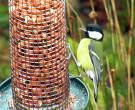 |
| (Top of page) |
February |
- Prepare vegetable seed beds, and sow some vegetables under cover
- Chit potato tubers
- Protect blossom on apricots, nectarines and peaches
- Net fruit and vegetable crops to keep the birds off
- Prune winter-flowering shrubs that have finished flowering
- Divide bulbs such as snowdrops, and plant those that need planting 'in the green’
- Prune Wisteria
- Prune hardy evergreen hedges and renovate overgrown deciduous hedges
- Prune conservatory climbers
- Cut back deciduous grasses left uncut over the winter
|
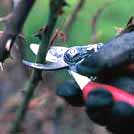 |
| (Top of page) |
March |
- Plant shallots, onion sets and early potatoes
- Protect new spring shoots from slugs
- Plant summer-flowering bulbs
- Lift and divide overgrown clumps of perennials
- Top dress containers with fresh compost
- Mow the lawn on dry days (if needed)
- Cut back Cornus (dogwood) and Salix (willow) grown for colourful winter stems
- Weeds come back in to growth - deal with them before they get out of hand
- Start feeding fish and using the pond fountain; remove pond heaters
- Open the greenhouse or conservatory doors and vents on warm days
|
 |
| (Top of page) |
April |
- Keep weeds under control
- Protect fruit blossom from late frosts
- Tie in climbing and rambling roses
- Sow hardy annuals and herb seeds
- Start to feed citrus plants
- Increase the water given to houseplants
- Feed hungry shrubs and roses
- Sow new lawns repair bare patches
- Prune fig trees
- Divide bamboos and waterlilies
|
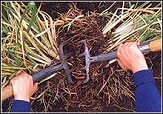 |
| (Top of page) |
May |
- Watch out for late frosts. Protect tender plants
- Earth up potatoes, and promptly plant any still remaining
- Plant out summer bedding at the end of the month (except in cold areas)
- Collect rainwater and investigate ways to recycle water for irrigation
- Regularly hoe off weeds
- Open greenhouse vents and doors on warm days
- Mow lawns weekly
- Check for nesting birds before clipping hedges
- Lift and divide overcrowded clumps of daffodils and other spring-flowering bulbs
- Watch out for viburnum beetle and lily beetle grubs
|
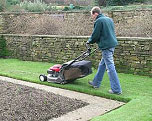 |
| (Top of page) |
June |
- Hoe borders regularly to keep down weeds
- Be water-wise, especially in drought-affected areas
- Pinch out sideshoots on tomatoes
- Harvest lettuce, radish, other salads and early potatoes
- Position summer hanging baskets and containers outside
- Mow lawns weekly
- Plant out summer bedding
- Stake tall or floppy plants
- Prune many spring-flowering shrubs
- Shade greenhouses to keep them cool and prevent scorch
|
 |
| (Top of page) |
July |
- Check clematis for signs of clematis wilt
- Place conservatory plants outside now that it is warm
- Water tubs and new plants if dry, but be water-wise
- Deadhead bedding plants and repeat-flowering perennials, to ensure continuous flowering
- Pick courgettes before they become marrows
- Treat apple scab
- Clear algae, blanket weeds and debris from ponds, and keep them topped up
- Order catalogues for next year’s spring-flowering bulbs
- Give the lawn a quick-acting summer feed, especially if a spring feed was not done
- Give woodwork a lick of paint or preserver, while the weather is dry
|
 |
| (Top of page) |
August |
- Prune Wisteria
- Don’t delay summer pruning restricted fruits
- Deadhead flowering plants regularly
- Watering! Particularly containers, and new plants - preferably with grey recycled water or stored rainwater
- Collect seed from favourite plants
- Harvest sweetcorn and other vegetables as they become ready
- Continue cutting out old fruited canes on raspberries
- Lift and pot up rooted strawberry runners
- Keep ponds and water features topped up
- Feed the soil with green manures
|
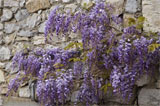 |
| (Top of page) |
September |
- Divide herbaceous perennials
- Pick autumn raspberries
- Collect and sow seed from perennials and hard y annuals
- Dig up remaining potatoes before slug damage spoils them
- Net ponds before leaf fall gets underway
- Keep up with watering of new plants, using rain or grey water if possible
- Start to reduce the frequency of houseplant watering
- Clean out cold frames and greenhouses so that they are ready for use in the Autumn
- Cover leafy vegetable crops with bird-proof netting
- Give evergreen hedges a final trim
|
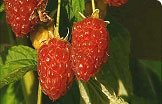 |
| (Top of page) |
October |
- Clear up fallen autumn leaves regularly
- Cut back perennials that have died down
- Divide herbaceous perennials and rhubarb crowns
- Move tender plants, including aquatic ones, into the greenhouse
- Plant out spring cabbages
- Harvest apples, pears, grapes and nuts
- Prune climbing roses
- Order seeds for next year
- Last chance to mow lawns and trim hedges in mild areas
- Renovate old lawns or create new grass areas by laying turf
|
 |
| (Top of page) |
November |
- Clear up fallen leaves - especially from lawns, ponds and beds
- Raise containers onto pot feet to prevent waterlogging
- Plant tulip bulbs for a spring display next year
- Prune roses to prevent wind-rock
- Plant out winter bedding
- Cover brassicas with netting if pigeons are a problem
- Insulate the greenhouse from frost - bubblewrap works well
- Stop winter moth damage to fruit trees using grease bands around the trunks
- Put out bird food to encourage winter birds into the garden
- Use a seasonal bonfire - where this is allowed - to dispose of excess debris unfit for composting
|
 |
| (Top of page) |
December |
- Check your winter protection structures are still securely in place
- Check that greenhouse heaters are working OK
- Prevent ponds and stand pipes from freezing
- Prune open-grown apples and pears (but not those trained against walls)
- Prune acers, birches and vines before Christmas to avoid bleeding
- Harvest leeks, parsnips, winter cabbage, sprouts and remaining root crops
- Deciduous trees and shrubs can still be planted and transplanted
- Take hardwood cuttings
- Keep mice away from stored produce
- Reduce watering of houseplants
|
 |
| (Top of page) |
Hempstead Rainfall Figures |
Below are graphs of our average rainfall taken by a villager since 1993. The figures are not official, just amateur readings but some of the information is fascinating:-
- Our driest year was 2005 at 386mm
- Our wettest year was 2012 at 790mm with 287mm falling between April and June
- The average rainfall over this 26 year period is 547mm per year (22”)
|
|
|
| (Top of page) |

